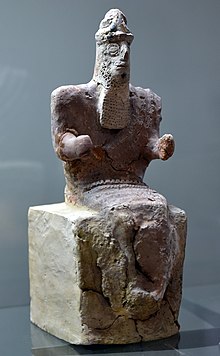
Back Enlil Afrikaans إنليل Arabic Enlil Azerbaijani اینلیل AZB Энліль Byelorussian Енлил Bulgarian Enlil Catalan Enlil Czech Энлиль CV Enlil Danish
| Enlil | |
|---|---|
 Statuette of Enlil sitting on his throne from the site of Nippur, dated to 1800–1600 BC, now on display in the Iraq Museum | |
| Cuneiform | 𒀭𒂗𒆤 |
| Abode | Nippur |
| Planet | Jupiter |
| Symbol | Horned crown |
| Genealogy | |
| Parents | An and Ki |
| Siblings | Enki |
| Consort | Ninlil, Ki |
| Children | Ninurta, Nanna, Nergal, Ninazu, and Enbilulu |
| Equivalents | |
| Babylonian | Elil, Marduk/Bel (cultic roles and epithets) |
| Hurrian | Kumarbi |
| Akkadian | Ellil |
| Canaanite | El (Dagan), Baal |
| Greek | Zeus |
Enlil,[a] later known as Elil and Ellil, is an ancient Mesopotamian god associated with wind, air, earth, and storms.[4] He is first attested as the chief deity of the Sumerian pantheon,[5] but he was later worshipped by the Akkadians, Babylonians, Assyrians, and Hurrians. Enlil's primary center of worship was the Ekur temple in the city of Nippur, which was believed to have been built by Enlil himself and was regarded as the "mooring-rope" of heaven and earth. He is also sometimes referred to in Sumerian texts as Nunamnir. According to one Sumerian hymn, Enlil himself was so holy that not even the other gods could look upon him. Enlil rose to prominence during the twenty-fourth century BC with the rise of Nippur. His cult fell into decline after Nippur was sacked by the Elamites in 1230 BC and he was eventually supplanted as the chief god of the Mesopotamian pantheon by the Babylonian national god Marduk.
Enlil plays a vital role in the ancient near eastern cosmology; he separates An (heaven) from Ki (earth), thus making the world habitable for humans. In the Sumerian flood myth Eridu Genesis, Enlil rewards Ziusudra with immortality for having survived the flood and, in the Babylonian flood myth, Enlil is the cause of the flood himself, having sent the flood to exterminate the human race, who made too much noise and prevented him from sleeping; the cuneiform tablets of Atra-Hasis report on this connections in a comparatively well-preserved state. The myth of Enlil and Ninlil is about Enlil's serial seduction of the goddess Ninlil in various guises, resulting in the conception of the moon-god Nanna and the Underworld deities Nergal, Ninazu, and Enbilulu. Enlil was regarded as the inventor of the mattock and the patron of agriculture. Enlil also features prominently in several myths involving his son Ninurta, including Anzû and the Tablet of Destinies and Lugale.
- ^ Halloran 2006.
- ^ Holland 2009, p. 114.
- ^ Nemet-Nejat 1998, p. 182.
- ^ Coleman & Davidson 2015, p. 108.
- ^ Kramer 1983, pp. 115–121.
Cite error: There are <ref group=lower-alpha> tags or {{efn}} templates on this page, but the references will not show without a {{reflist|group=lower-alpha}} template or {{notelist}} template (see the help page).